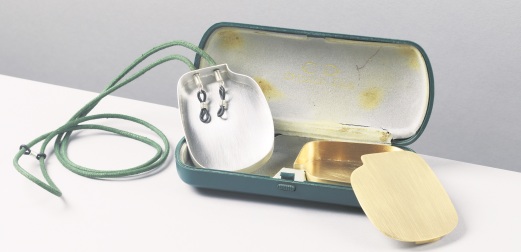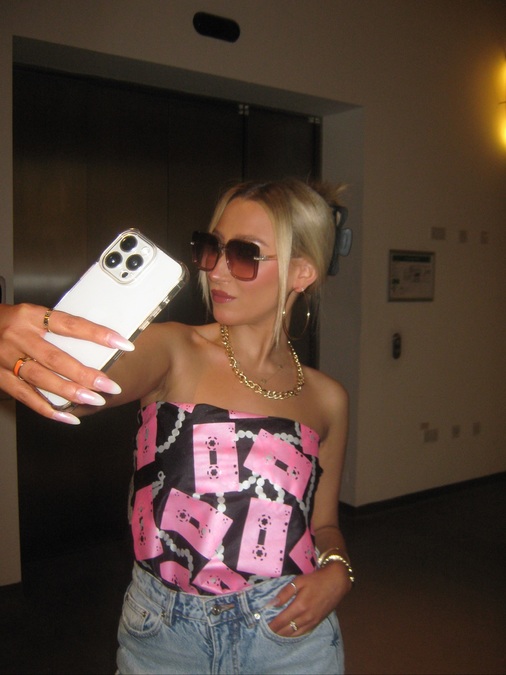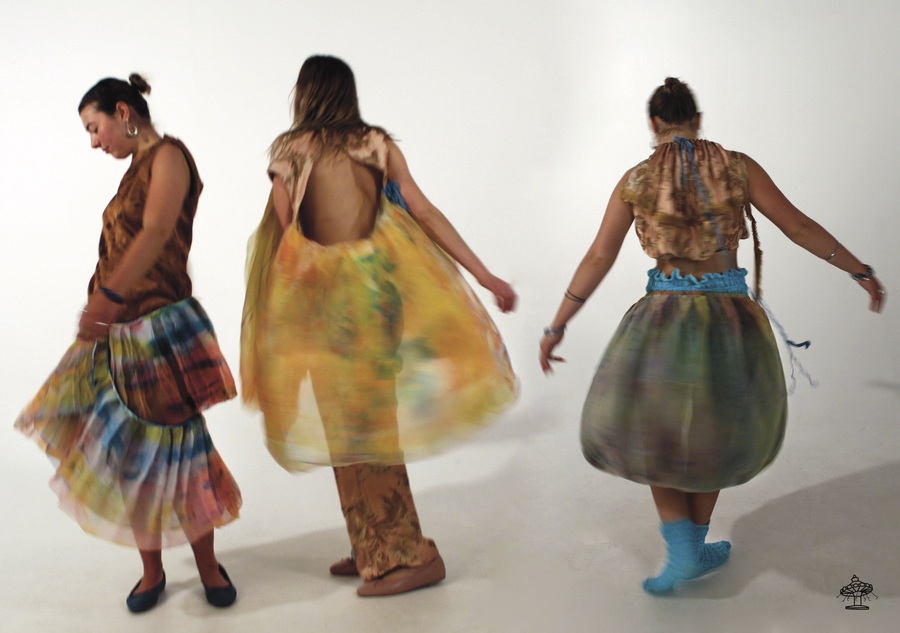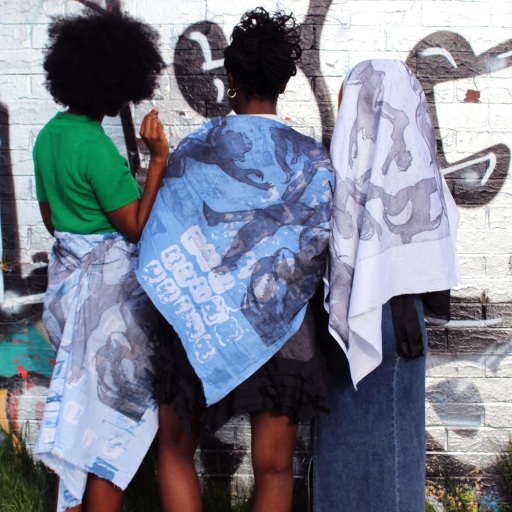GSA Degree Show 2024: School of Design
Based in the Reid Building, with its building-wide feeling of energy and community, it's no wonder that there is a playfulness, curiosity and quality attention to detail present in much of the work of the School of Design's 2024 cohort
The School of Design offers perspectives on common themes across various disciplines – 2024's graduating students produce designs with a considered combination of personal and sociocultural subjects.
The Silversmithing and Jewellery programme showcases a blend of narrative exploration and artistic innovation with sensitive use of materials. Lindsay Mahood pays homage to Scottish suffragettes and women's empowerment by recreating hunger strike medals with reclaimed wood. Using archival research and narrative storytelling, her pieces aim to preserve and amplify women's stories. Milly Milenkova draws inspiration from ancestral objects from relatives she has never encountered, using the negative space from glasses, watches, and vases in her collection of what could have been but never was. These objects, crafted with precious metals, embody the preciousness of memories passed down through generations, combining nostalgia with contemporary design. Imogen Hales blends traditional silversmithing techniques with playful, contemporary aesthetics. Her enamelled creations feature whimsical wiggles reminiscent of the techniques for making straw hats, exploring painterly mark-making and expression within the processes of traditional jewellery. Together, this cohort of artists exemplify the skill in transforming jewellery into vessels of remembrance, bridging past narratives with contemporary expressions of craft and creativity.

Silversmithing and Jewellery, by Milly Milenkova.
The Interaction Design programme showcases a range of projects questioning human interaction with technology and its potential for personal and cultural storytelling. Elle Crawley examines the realm of AI interfaces by creating a digital version of herself, inspired by her interest in video games and the ethical implications of AI-human interaction. Her project invites visitors to converse with an AI replica of Elle, pushing the boundaries of digital existence and posing thought-provoking questions about identity and reality. Moving away from digital interfaces and more toward nature, Jenny Coyle draws on her emotional connection to water and the beach, using art to confront grief and personal loss. Her sculptures play with the interaction between invisible deep bass sound vibrations and pools of water, releasing memories silently into the ripples. Similarly drawing on personal histories, Matthew Rose pays homage to his late father through a large-scale lighting sculpture. He combines tangible symbolic objects like transit van doors and tools with hazy LED light shows to create an immersive experience that celebrates memory. Each project within the Interaction Design course intertwines technology with personal narratives, provoking contemplation on the evolving relationship between humanity and digital interfaces.
The Product Design Engineering programme reimagines everyday experiences through innovative design and engineering. Jamie Sach’s project focuses on creating a simplified camera system that embraces repairability and sustainability. By stripping back the digital complexities, Jamie aims to provide a camera that can be kept, repaired, and updated over time, reducing electronic waste. The design allows beginner photographers to future-proof their camera as their skills progress and technology adapts.
Bailey Tuddenham explores the concept of portable immersive entertainment, incorporating touch, smell, and haptic feedback into a consumer product for on-the-go experiences. By integrating sensory elements like vibrations and scent dispersion, Bailey's design aims to elevate on-the-go media consumption into a multisensory adventure, enhancing engagement and immersion. Jessica Smith looks at affective sustainability in design. Her work challenges conventional notions of product lifecycle, proposing that emotional attachment can foster lasting relationships with belongings, akin to connections with loved ones. The PDE course nurtures innovation and creativity, embracing sustainability, user experience, and emotional resonance as integral components of forward-thinking design.
This year’s Textile Design students present projects that draw sensitively on a range of personal and cultural themes. Anna De Lange evokes warmth, familiarity and safety in the textures of her knitwork. In these fabrics you will find comfort. This artist views the world through a nostalgic lens, paying close attention to the spaces where the repetition of ordinary moments leads us to construct unconscious relationships with space. In the gradient stripes and layered tones of this collection, built around a colour palette reminiscent of Kodak Gold film stock, there is a tactility, and a relaxed sense of domesticity.
Bonnie Magee’s The Feminine Grotesque is a collection of designs that take the form of something recognisably organic, bodily and striking. Strings of stiff, malleable lace are twisted alongside lengths of folded ribbon to create fluid pieces that feel at once elegant and unsettlingly corporeal. She creates textures inspired by organs, taxidermy and dismembered body parts found in museums with delicately sculptural techniques, imbuing darkness and mystery into her fabrics.
Playful in her use of colour, Katie Monteith’s weaving puts a spin on traditional women’s formalwear. Structural and defined, these designs are informed by her immediate physical environment – previously the moss, water and greenery of Northern Ireland; currently the intricacies of Glasgow’s varied architecture. This translates into the collection as tight lines of weaving, grounded in the recurring saturated colours of tay, blue, and purple. Through an interpretation of her current surroundings, Katie seeks to construct a love letter to home.

Textile Design, by Ross Anderson.
Working with print, Ross Anderson’s work is dripping in opulence. Maximalist in pattern and making explicit reference to high fashion and ballroom culture of the 80s and 90s, his designs return to images of jewellery – combining silver chains and gold watches with bold pinks and metallic blacks. His motifs are intended for fashion pieces, and his degree show presentation toys with ideas of consumerism as he employs a Barbie Doll box aesthetic to display each look. This maker’s intention is to embrace inspiration from music, bygone eras and global subcultures.
The Fashion Design cohort produce garments combining traditional and contemporary media, exploring themes of heritage and nostalgia. Knit and family are key to the work of Rose Davenport, who has used hand-sheared wool from a sheep named Olive to construct a traditional Scottish fabric skirt. In Faileas, a Gaelic word meaning reflection, shadow or echo, and the title of Rose’s project, she reflects on her heritage and the history of Scottish knitting. Using the three-step process of carding, spinning and knitting, she has combined raw wool with yarn to create a chunky skirt that calls to the Scottish countrysides of Rose’s family holidays.
Interested in perspective, Lola Clementine has constructed a collection of garments that centre around movement. Spinning – and the volume that this motion creates – is at the forefront of their intent with this work, titled Life Is a Carnival. In the form of zines, the garments are presented alongside a selection of the artist’s watercolour illustrations, contributing a refreshingly tactile element to the presentation. Lola’s watercolours feel inquisitive and playful, and are translated into her fabrics through sublimation print.

Fashion Design, by Lola Clementine.
The graduates from Communication Design present thoughtful and inventive ways of engaging with the world – particularly challenging, perhaps, in an era saturated with information and images. Explorations of culture and community connect across the year group, with many students returning to material methods of making to realise their ideas.
There is an electric quality to the illustrations of Lizzie Eidson, whose work occupies a vibrant landscape of drawing and printmaking, books and zines. Inspiration for Lizzie often stems from the personal – the ritual of the hair salon, a childhood love of roller skating, memories of her grandparents’ clothes. These vivid ribbons of experience are woven by Lizzie into rich narratives engaging POC spaces. A desire for connection, both with specific communities and more broadly across cultures, appears as a driving force behind her practice.
In her risograph magazine Viewfinder, Rose Smith draws our gaze towards moments of curiosity hidden among the banal. The publication riffs on the seemingly archaic concept of a weekly newspaper – its simple monochromatic design a perfect foil for Rose’s idiosyncratic images. The subtlety and humour which runs through Viewfinder also finds connection to Rose’s film work. Her short documentary on the GSA’s unofficial football team offers a lively and unexpectedly moving account of the connection that sport forges between students.

Communication Design, by Lizzie Eidson.
This year’s Interior Design graduates present a generous and inspiring vision for Glasgow’s future in their work to adapt and regenerate the city’s derelict buildings. The rich history of the Clyde canals is brought to a public audience by Ishika Talukdar, who transforms one of the river’s disused boat houses into a dynamic exhibition centre. Featuring a range of interactive exhibits and a floating canal boat cafe, Ishika hopes to create an engaging space for children and families – inspired by fond memories of her own childhood.
Ewan Murphy’s project is also a reimagining of the exhibition space, highlighting the often-neglected intersection between science and the arts through an ambitious Science Gallery. Ewan’s emphasis towards kinaesthetic learning is particularly innovative, including a thermochromic star chart and expanding planetarium.
Similarly inventive is Rachel Hendry’s proposal for the Temple Gasworks. Rachel plans for the site to be transformed into an immersive visitor experience, channelling Edmund Burke’s philosophy of the Sublime. Through ingenious use of materials, the seven floors embody various states including obscurity, privation, magnificence – inviting the audience to transcend the limits of their ordinary perspective.

Interior Design, by Rachel Hendry.
Kat McDicken’s Cultural Community Centre aims to bridge the gap between makers and buyers through a dynamic, Latin American-inspired marketplace. Accessibility and inclusivity lie at the heart of her design – the space tailored for a neurodiverse audience with vibrant colour-coding and sensory cues. As Kat explains: "Design for people who are neurodiverse is design for everyone."
The work of Haeun Kim makes an equally bold statement, embracing the needs of the designers post-art school. With shared studios, workshops and exhibition spaces, Haeun’s Maker’s Playground offers a platform for graduates and established designers to develop practical skills and cultivate their creativity.
School of Design Degree Show, Reid Building, 31 May-9 June
